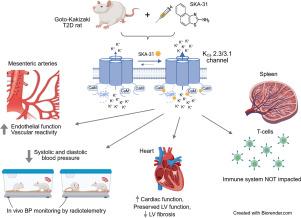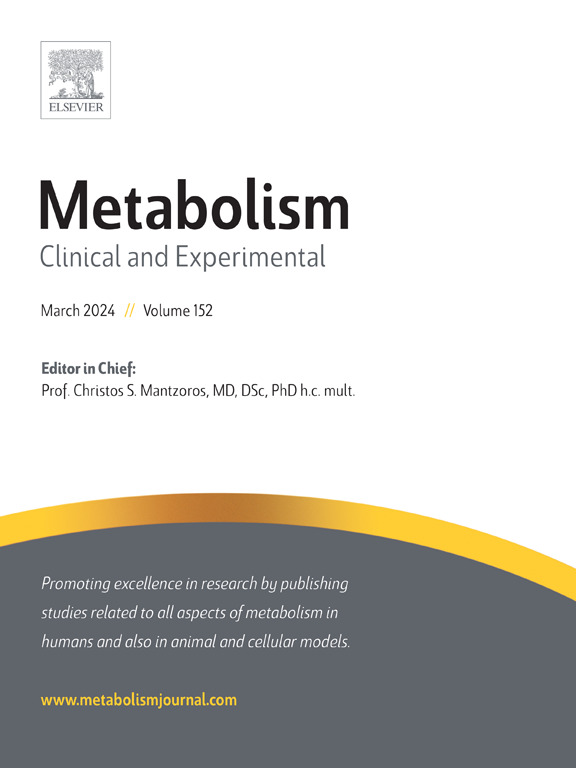KCa通道激活剂SKA-31可改善2型糖尿病大鼠的长期内皮功能、血压调节和心脏功能。
IF 11.9
1区 医学
Q1 ENDOCRINOLOGY & METABOLISM
引用次数: 0
摘要
目的:本研究的目的是研究长期服用选择性KCa通道激活剂SKA-31是否会减轻自发性T2D成年雄性Goto-Kakizaki (GK)大鼠2型糖尿病(T2D)相关心血管(CV)并发症的发展/严重性。方法:使用无线电遥测仪的成年雄性T2D GK大鼠,于~14 周龄每日腹腔注射载药或KCa通道激活剂SKA-31(10 mg/kg),连续12周。在体内和离体分析治疗后的心血管功能、免疫系统状态、血管信号和代谢激素。结果:经超声心动图检测,经药物处理的T2D GK大鼠的收缩压和舒张压逐渐升高,而SKA-31可降低平均动脉压,并改善心功能(即射血分数、分数缩短)和结构(即收缩期和舒张末期容积)。通过动脉压肌图检测,SKA-31在体内治疗进一步改善了肠系膜小动脉的血管内皮功能,并增加了血管壁血管舒张信号分子的蛋白表达。长期ka -31治疗不会损害骨骼肌和冠状动脉的血管舒张反应性,也不会引起T2D GK大鼠的促炎反应,也不会对脑、肾或肝产生任何不良组织学影响。结论:我们的研究结果表明,在建立的自发性T2D大鼠模型中,低剂量的KCa通道激活剂SKA-31改善了CV功能,并揭示了一种潜在的对抗T2D中CV相关发病率的新策略。本文章由计算机程序翻译,如有差异,请以英文原文为准。

Administration of the KCa channel activator SKA-31 improves long-term endothelial function, blood pressure regulation and cardiac performance in rats with type 2 diabetes
Objective
Our goal in the present study was to examine whether long-term administration of the selective KCa channel activator SKA-31 would mitigate the development/severity of type 2 diabetes (T2D)-associated cardiovascular (CV) complications in adult male Goto-Kakizaki (GK) rats with spontaneous T2D.
Methods
Adult male T2D GK rats instrumented with radio-telemeters were administered either vehicle or the KCa channel activator SKA-31 (10 mg/kg) at ~14 weeks of age by daily intraperitoneal injection for 12 consecutive weeks. In vivo and ex vivo analyses of CV function, immune system status, vascular signaling and metabolic hormones were performed following treatment.
Results
Vehicle-treated T2D GK rats exhibited gradual increases in systolic and diastolic blood pressure, whereas SKA-31 administration led to lower mean arterial pressure, along with improvements in cardiac function (i.e., ejection fraction, fractional shortening) and structure (i.e., end systolic and diastolic volumes), as determined by echocardiography. SKA-31 treatment in vivo further improved vascular endothelial function in small mesenteric arteries, as determined by arterial pressure myography, and increased the protein expression of vasodilatory signaling molecules in the vascular wall. Prolonged SKA-31 treatment did not impair vasodilatory responsiveness in skeletal muscle and coronary arteries, elicit a pro-inflammatory profile in T2D GK rats or produce any adverse histological effects in brain, kidney or liver.
Conclusions
The results of our study demonstrate that low-dose administration of the KCa channel activator SKA-31 improved CV function in an established rat model of spontaneous T2D and reveal a potential novel strategy to oppose CV-related morbidity in T2D.
求助全文
通过发布文献求助,成功后即可免费获取论文全文。
去求助
来源期刊

Metabolism: clinical and experimental
医学-内分泌学与代谢
CiteScore
18.90
自引率
3.10%
发文量
310
审稿时长
16 days
期刊介绍:
Metabolism upholds research excellence by disseminating high-quality original research, reviews, editorials, and commentaries covering all facets of human metabolism.
Consideration for publication in Metabolism extends to studies in humans, animal, and cellular models, with a particular emphasis on work demonstrating strong translational potential.
The journal addresses a range of topics, including:
- Energy Expenditure and Obesity
- Metabolic Syndrome, Prediabetes, and Diabetes
- Nutrition, Exercise, and the Environment
- Genetics and Genomics, Proteomics, and Metabolomics
- Carbohydrate, Lipid, and Protein Metabolism
- Endocrinology and Hypertension
- Mineral and Bone Metabolism
- Cardiovascular Diseases and Malignancies
- Inflammation in metabolism and immunometabolism
 求助内容:
求助内容: 应助结果提醒方式:
应助结果提醒方式:


